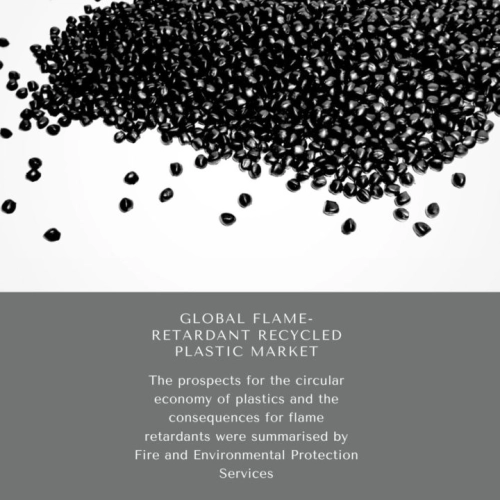
- Get in Touch with Us

Last Updated: Apr 25, 2025 | Study Period: 2022-2030
The prospects for the circular economy of plastics and the consequences for flame retardants were summarised by Fire and Environmental Protection Services. To increase the amount of time people have to flee fires, flame retardants are employed in a variety of polymers.

By definition, they are only intended to carry out this function in the event of a fire, at which point the plastic's lifespan is considered to have ended. Plastics can be recycled mechanically, chemically and used as a feedstock or energy source, or they can be used as energy themselves.
It has been demonstrated that a number of FR/polymer combinations are suitable with mechanical recycling.
The Global Flame-Retardant Recycled Plastic Market accounted for $XX Billion in 2021 and is anticipated to reach $XX Billion by 2030, registering a CAGR of XX% from 2022 to 2030.
The United Arab Emirates University (UAEU) in Al Ain and Charles Darwin University (CDU) in Darwin, Australia are collaborating with the American Chemistry Council's (ACC) North American Flame Retardant Alliance (NAFRA) to create new methods for recovering and recycling bromine and antimony from flame-retardant plastics.
The project's outcomes are anticipated to give modelling and laboratory data to take the technology to a pilot-plant stage.
The project's goal is to investigate novel techniques for safely and effectively extracting bromine and antimony from polymers before recycling the polymeric matrix into monomers and useful fuels.
An alternative to flame retardant oil-based plastic has been introduced by Floreon, a UK-based business that creates high performance bioplastics.
A safe and environmentally friendly alternative for electrical goods, the halogen-free bioplastic made from plants is suited for mechanical and chemical recycling and has a carbon footprint that is up to seven times smaller than that of oil-based plastic.
A carbon-fiber reinforced composite material that resists flames has been created.
The Korea Institute of Science and Technology (KIST) reported that a research team from its Institute of Advanced Composite Materials created a flame-resistant carbon fibre reinforced plastic (CFRP) and presented a method for its environmentally friendly recycling using tannic acid derived from plants.
| Sl no | Topic |
| 1 | Market Segmentation |
| 2 | Scope of the report |
| 3 | Abbreviations |
| 4 | Research Methodology |
| 5 | Executive Summary |
| 6 | Introduction |
| 7 | Insights from Industry stakeholders |
| 8 | Cost breakdown of Product by sub-components and average profit margin |
| 9 | Disruptive innovation in the Industry |
| 10 | Technology trends in the Industry |
| 11 | Consumer trends in the industry |
| 12 | Recent Production Milestones |
| 13 | Component Manufacturing in US, EU and China |
| 14 | COVID-19 impact on overall market |
| 15 | COVID-19 impact on Production of components |
| 16 | COVID-19 impact on Point of sale |
| 17 | Market Segmentation, Dynamics and Forecast by Geography, 2022-2030 |
| 18 | Market Segmentation, Dynamics and Forecast by Product Type, 2022-2030 |
| 19 | Market Segmentation, Dynamics and Forecast by Application, 2022-2030 |
| 20 | Market Segmentation, Dynamics and Forecast by End use, 2022-2030 |
| 21 | Product installation rate by OEM, 2022 |
| 22 | Incline/Decline in Average B-2-B selling price in past 5 years |
| 23 | Competition from substitute products |
| 24 | Gross margin and average profitability of suppliers |
| 25 | New product development in past 12 months |
| 26 | M&A in past 12 months |
| 27 | Growth strategy of leading players |
| 28 | Market share of vendors, 2022 |
| 29 | Company Profiles |
| 30 | Unmet needs and opportunity for new suppliers |
| 31 | Conclusion |
| 32 | Appendix |